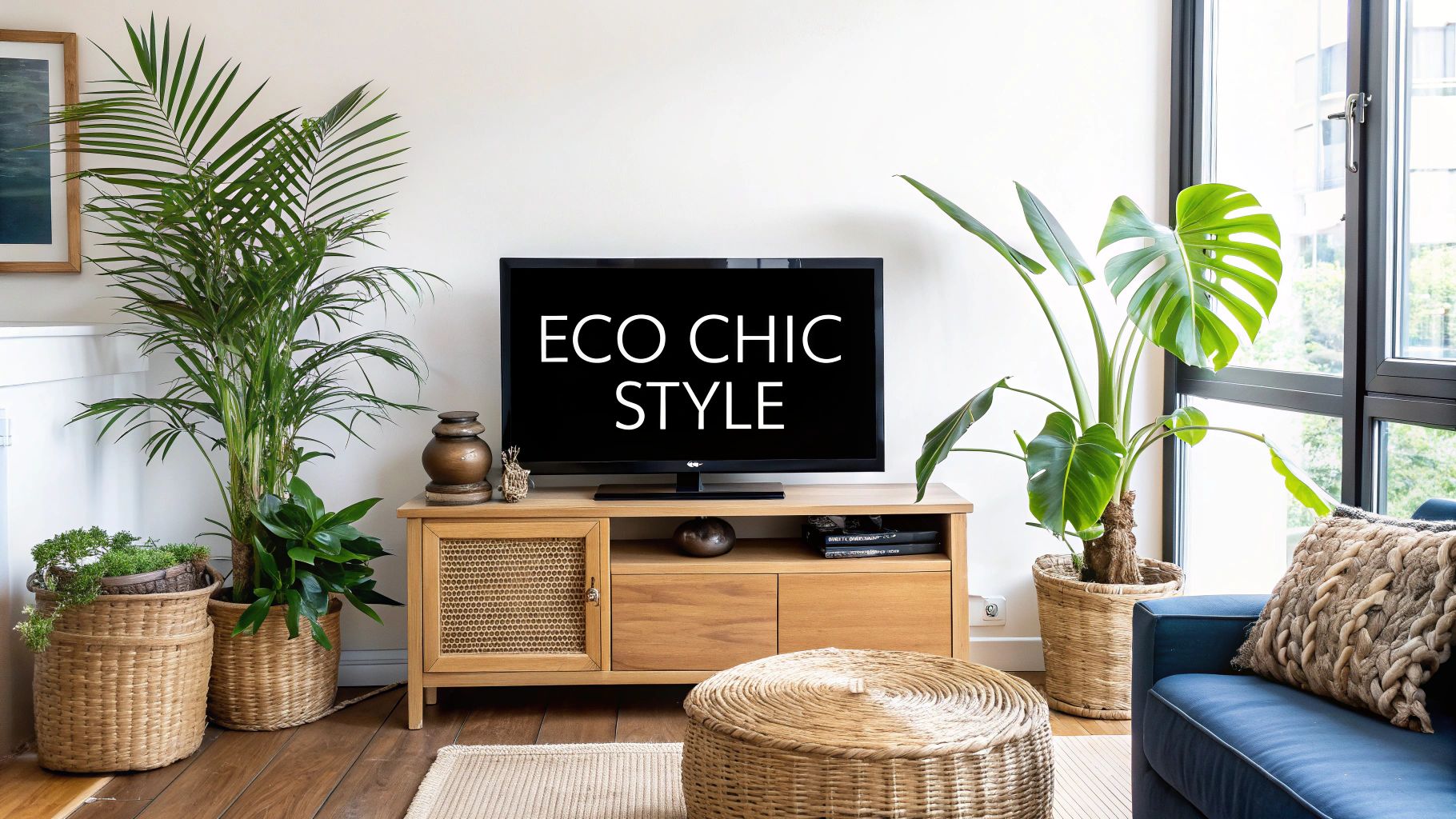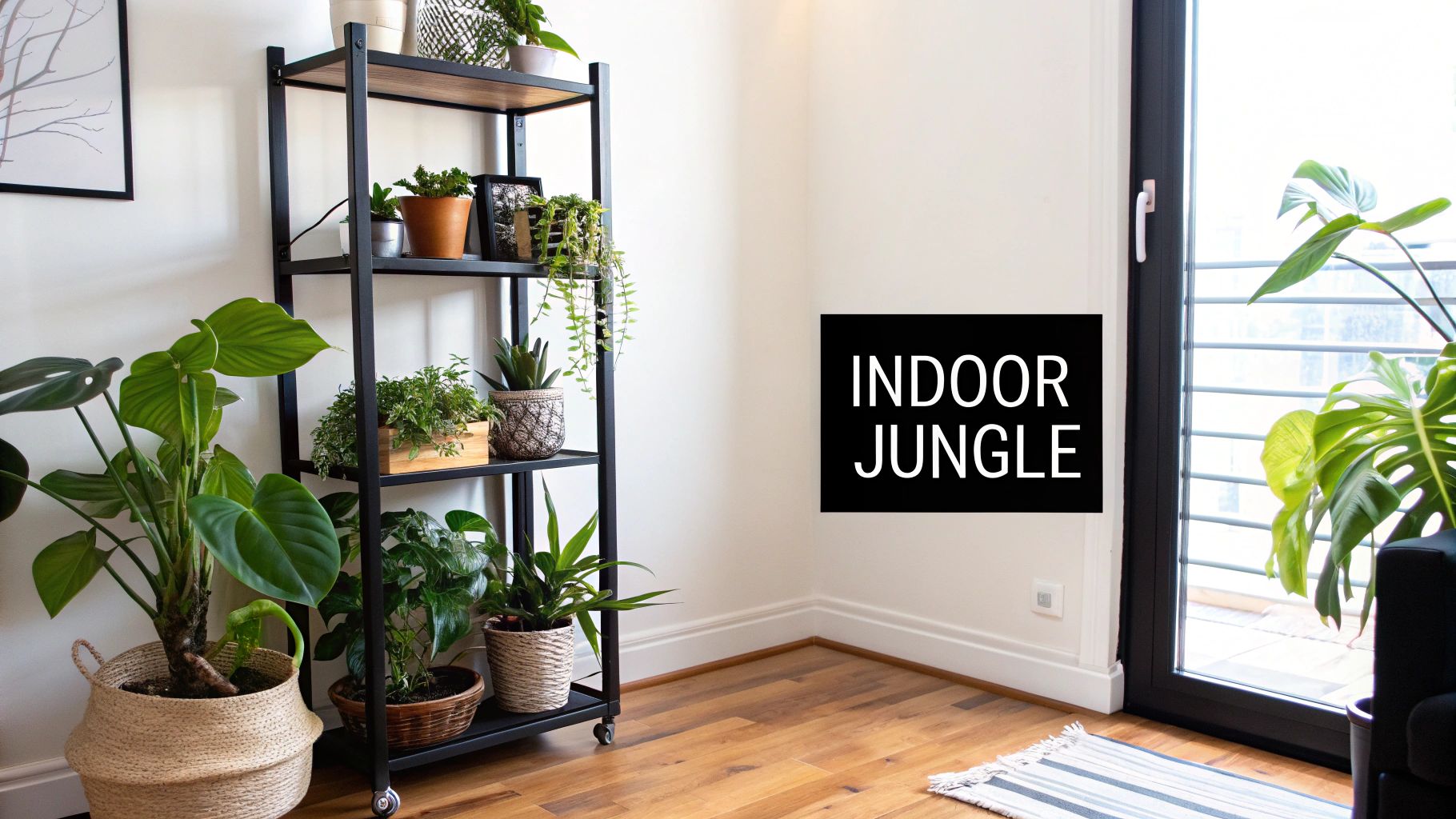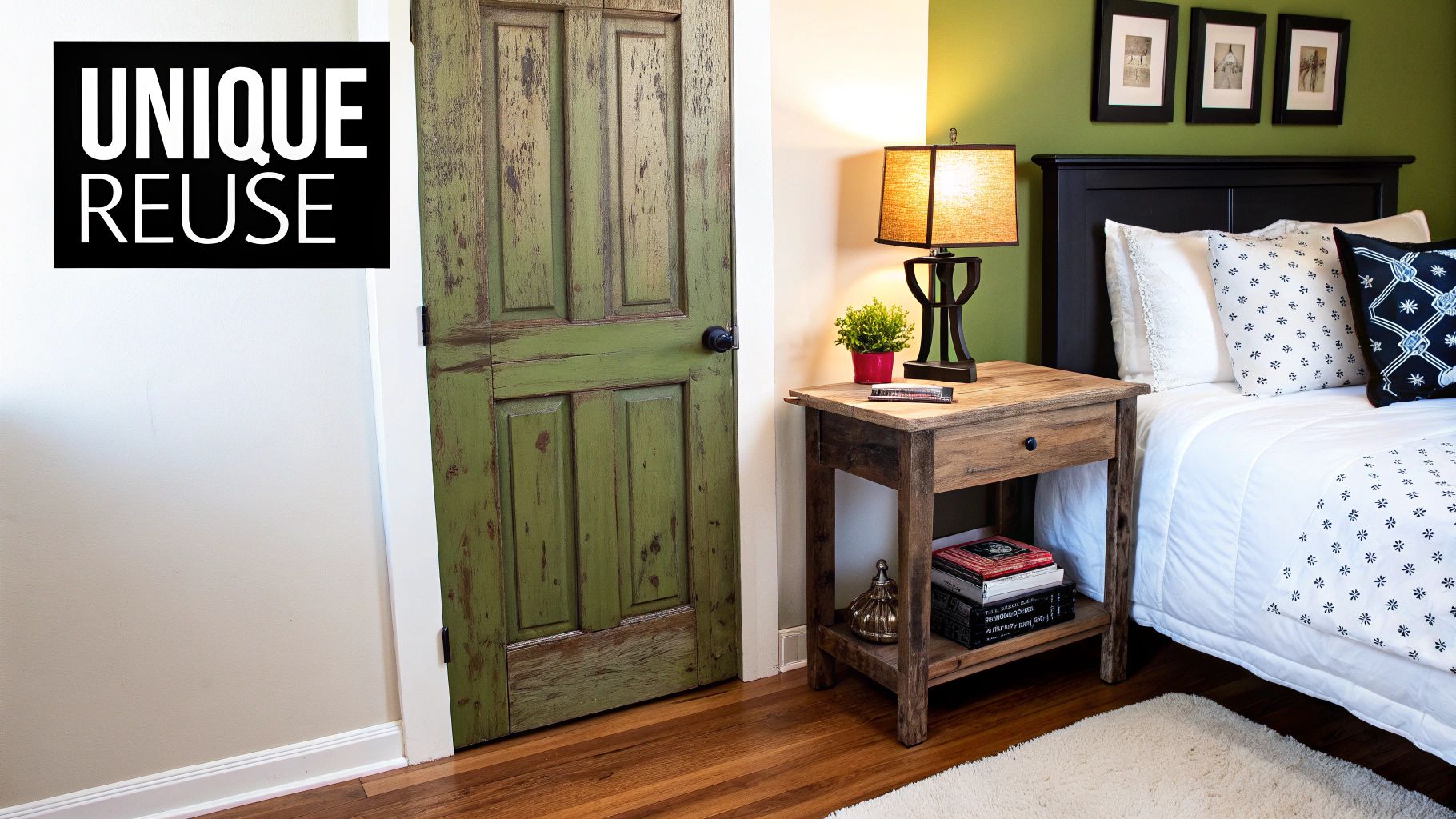Transform Your Space with Green Home Decor Ideas

Embrace Eco-Chic Style
Want a stylish and sustainable home? This listicle provides seven key elements of green home decor to minimise your environmental impact without compromising on aesthetics. Discover how incorporating indoor plant styling, sustainable furniture, biophilic design, upcycled decor, eco-friendly textiles, natural wall treatments, and energy-efficient lighting can transform your New Zealand or Australian home. Create a space that's both beautiful and environmentally responsible.
1. Indoor Plant Styling
Indoor plant styling is a versatile and effective approach to green home decor that involves strategically placing houseplants to enhance your interior design. It's about more than just adding a few pots here and there; it's about thoughtfully incorporating living elements that complement your existing decor, improve air quality, and bring a touch of nature indoors. This approach can range from a few carefully chosen statement plants in a minimalist setting to a vibrant indoor jungle teeming with diverse species. The flexibility of indoor plant styling allows for personalization based on your space, the available light, your personal style, and how much time you're willing to dedicate to plant care. This makes it an ideal green home decor solution for everyone from apartment dwellers in Auckland to homeowners in sprawling Queenstown properties.

Indoor plant styling offers a range of benefits beyond just aesthetics. Living plants act as natural air purifiers, removing toxins and improving indoor air quality, which is especially beneficial in well-insulated NZ homes. They also add humidity to dry indoor environments, creating a more comfortable and healthy living space. The presence of plants has been shown to reduce stress and promote a sense of well-being, creating a calming and inviting atmosphere. Furthermore, compared to other decor elements, plants are a relatively affordable way to transform a space, especially if you start with readily available varieties and propagate your own cuttings. This makes it a sustainable and budget-friendly option for green home decor.
From small succulents perched on shelves to large floor plants creating focal points, the variety in size, texture, and colour offered by foliage allows for endless design possibilities. Plants can be displayed in decorative pots, hanging planters, or even wall installations, adapting to various rooms and lighting conditions. Whether you're aiming for a lush, tropical feel or a more minimalist, modern aesthetic, indoor plant styling can be tailored to suit any design preference.
Pros:
- Naturally purifies indoor air by removing toxins.
- Adds humidity to dry indoor environments, common in NZ homes.
- Creates a connection to nature that reduces stress and boosts well-being.
- Relatively affordable compared to other decor elements.
- Living decor that grows and evolves over time, adding dynamism to a space.
Cons:
- Requires regular maintenance and care, which can be time-consuming.
- Some plants can be toxic to pets, so careful selection is essential.
- May attract insects if not properly maintained.
- Limited options for very low-light spaces.
- Can be challenging for those without a green thumb.
Examples of Successful Implementation:
- The "Urban Jungle" trend, showcasing homes filled with diverse plant collections, is a testament to the popularity of indoor plant styling.
- Plant stylist Hilton Carter's Baltimore home, featuring over 200 plants, provides inspiring examples of how to integrate plants into every room.
- Amazon's Spheres in Seattle demonstrate how indoor plant styling can be implemented on a larger scale, incorporating over 40,000 plants into their workspace.
Tips for Indoor Plant Styling in NZ:
- Start with low-maintenance plants: Snake plants, pothos, and ZZ plants are great choices for beginners and thrive in NZ conditions.
- Group plants with similar light and water needs together: This simplifies care and ensures that all your plants get the right conditions.
- Use plant stands and shelving to create vertical interest: Maximize space and showcase your plants effectively.
- Choose pots that complement your existing decor style: Integrate plants seamlessly into your overall aesthetic.
- Rotate plants regularly for even growth and to prevent leaning toward light sources: Especially important in NZ's changing seasons.
Indoor plant styling deserves its place on this list as a fundamental element of green home decor. It's accessible, versatile, and offers a multitude of benefits, from improving air quality to boosting well-being. By understanding the basic principles and following a few simple tips, you can easily transform your NZ home into a thriving green oasis.
2. Sustainable Furniture
Sustainable furniture is a cornerstone of green home decor. It prioritizes environmentally responsible production by using renewable, recycled, or reclaimed materials, minimizing ecological impact from start to finish. This approach emphasizes durability, timeless design, and ethical manufacturing processes, creating pieces that are both beautiful and environmentally conscious. By choosing sustainable furniture, you're reducing the carbon footprint of your home furnishings while supporting responsible forestry and production practices.

Sustainable furniture often features natural textures and organic forms, adding unique character to your home. Materials range from reclaimed wood and bamboo to recycled aluminum and repurposed rubberwood. Look for pieces made with non-toxic finishes and adhesives to ensure a healthy indoor environment. Many sustainable furniture pieces are handcrafted or locally produced, further minimizing environmental impact and supporting local artisans. When selecting furniture, consider the materials used and their impact on the environment. Choosing sustainable options like bamboo or reclaimed wood can significantly reduce your carbon footprint. For a deeper dive into eco-conscious kitchen design, explore this guide on eco-friendly kitchen cabinets.
Features of Sustainable Furniture:
- Made from responsibly sourced or reclaimed materials
- Non-toxic finishes and adhesives
- Designed for longevity and durability
- Often handcrafted or locally produced
- Many pieces feature natural textures and organic forms
Pros:
- Reduces environmental impact compared to conventional furniture
- Often higher quality and longer-lasting than mass-produced items
- Free from harmful chemicals found in conventional furniture
- Supports ethical manufacturing practices and fair labor
- Creates unique character through natural materials
Cons:
- Generally more expensive upfront than mass-produced furniture
- Limited style options compared to conventional furniture
- May require special care or maintenance
- Can be difficult to verify sustainability claims
- Limited availability in some regions
Examples in the Market:
- West Elm's reclaimed wood dining tables
- Medley's handcrafted organic sofas made with FSC-certified wood
- Emeco Navy Chair made from recycled aluminum
- Thuma's platform bed made from repurposed rubberwood
- Vermont Wood Studios' sustainably harvested hardwood furniture
Tips for Choosing Sustainable Furniture:
- Look for FSC certification for wood products.
- Choose pieces made with natural, non-toxic finishes.
- Invest in quality over quantity for longer-lasting furniture.
- Seek out local craftspeople in NZ to reduce transportation emissions.
- Consider multipurpose furniture to maximize utility.
- Research companies' sustainability practices beyond their marketing.
Pioneers in Sustainable Furniture:
- Mitchell Gold + Bob Williams
- Cisco Home
- Medley
- Viva Terra
- Herman Miller
Sustainable furniture deserves a place in every green home decor strategy due to its positive impact on the environment and its potential to create stylish and healthy living spaces. By prioritizing sustainable materials and ethical production, you can furnish your home with pieces that are both beautiful and responsible. Learn more about Sustainable Furniture for further insights into green upholstery options.
3. Biophilic Design Elements
Biophilic design is a powerful approach to green home decor that taps into our inherent human connection with nature. It goes beyond simply adding a few pot plants – it's about weaving natural elements, patterns, and processes into the very fabric of our interior spaces. This creates environments that not only look beautiful but also nurture our well-being, boosting creativity, reducing stress, and even improving cognitive function. By incorporating natural materials, organic shapes, nature-inspired colours, and maximizing natural light, biophilic design fosters a sense of calm and connection to the natural world within our homes and workplaces.

Biophilic design encompasses both direct and indirect experiences of nature. Direct experiences involve incorporating elements like indoor plants, water features, and maximizing natural light and ventilation. Think of a sun-drenched room filled with lush greenery and the gentle sound of a trickling water fountain. Indirect experiences, on the other hand, utilize natural materials like timber, stone, and wool, along with nature-inspired colours and textures. Imagine a living room with exposed wooden beams, a stone fireplace, and furnishings upholstered in earthy tones. Even mimicking natural patterns and forms, known as biomimicry, contributes to the overall biophilic design.
This approach deserves a place on any green home decor list because it offers a holistic way to create healthier, more vibrant, and environmentally friendly spaces. The benefits are numerous. Studies show that biophilic design can reduce stress and improve mental well-being, enhance creativity and cognitive function, improve air quality and acoustic comfort, and create visually interesting and dynamic spaces. For Kiwis, known for their love of the outdoors, incorporating biophilic design can help seamlessly blend the beauty of New Zealand’s natural landscapes into their interior spaces.
Of course, there are some considerations. Implementing biophilic design comprehensively can be costly, and it requires thoughtful planning and design expertise. Some elements, like living walls or water features, require regular maintenance. Natural materials may also need special care or treatments. Furthermore, the aesthetic may not complement all interior styles, particularly minimalist or ultra-modern ones.
Here are some practical tips to bring biophilic design into your New Zealand home:
- Maximize Natural Light: Use strategic window treatments, like sheer curtains or blinds, to allow ample natural light to flood your space.
- Embrace Natural Materials: Incorporate sustainable timbers like Rimu or Matai, locally sourced stone, and natural fibres like wool and flax into your decor.
- Nature-Inspired Colour Palettes: Opt for colour palettes inspired by the New Zealand landscape – think calming greens, deep blues, and earthy tones.
- Connect to the Outdoors: Create visual connections to outdoor spaces through large windows and strategically placed mirrors. Consider adding a deck or patio to extend your living space into nature.
- Natural Ventilation: Maximize natural airflow with operable windows and consider installing a ventilation system to improve indoor air quality.
Examples of successful biophilic design can be seen globally, from the plant-filled Amazon Spheres in Seattle to the Bosco Verticale residential towers in Milan with their tree-covered balconies. Closer to home, you can find inspiration in architectural projects that embrace the natural beauty of New Zealand. Learn more about Biophilic Design Elements for further inspiration.
By embracing biophilic design principles, you can create green home decor that not only enhances the beauty of your home but also nourishes your well-being and fosters a deeper connection to the natural world. This approach is particularly relevant for New Zealanders, allowing them to bring the serenity and vibrancy of their unique environment indoors.
4. Upcycled and Repurposed Decor
Upcycled and repurposed decor is a cornerstone of green home design, offering a creative and eco-conscious approach to furnishing and decorating. This sustainable practice involves transforming discarded, vintage, or antique items into functional and artistic home elements. By giving existing materials a second life, you reduce waste sent to landfills while adding unique character and history to your space. This method aligns perfectly with the growing Kiwi focus on sustainability and resourcefulness, making it a popular choice for environmentally conscious homeowners in New Zealand and Australia.

From furniture made of salvaged timber to decorative items crafted from repurposed objects, the possibilities are endless. Imagine a vintage door from a demolished villa in Wellington transformed into a unique headboard, or wine barrels from a Marlborough vineyard repurposed as stylish bathroom vanities. Industrial spools can become striking coffee tables, while old mason jars can be upcycled into charming light fixtures or planters. Even pallet wood, readily available throughout NZ, can be transformed into rustic wall art or furniture. This approach not only reduces your environmental impact but also infuses your interiors with personality and a sense of story.
Why Choose Upcycled and Repurposed Decor?
This method deserves a place on any green home decor list due to its significant environmental and aesthetic benefits. It directly tackles the issue of waste, reduces the demand for new resources, and offers a pathway to create truly unique, one-of-a-kind pieces. It's a fantastic way to incorporate a piece of New Zealand's history and heritage into your home. For businesses, particularly in hospitality, upcycled decor can contribute to a distinct brand identity that resonates with environmentally conscious customers.
Features and Benefits:
- Transforms discarded items: Gives new life to items destined for landfill.
- Incorporates vintage/antique elements: Adds character and historical context.
- Unique character and patina: Each piece tells a story.
- Combines different materials: Fosters creativity and innovative design.
- Handcrafting and DIY: Offers opportunities for personalization and skill development.
Pros:
- Reduces waste: Diverts materials from landfills.
- Unique pieces: Creates one-of-a-kind decor.
- Cost-effective: Often less expensive than buying new.
- Historical context: Adds storytelling elements to spaces.
- Supports local artisans & circular economy: Benefits local craftspeople and reduces reliance on mass production.
Cons:
- Time-consuming: Sourcing and creating can take time.
- DIY skills: May require specific tools and abilities.
- Variable quality: Durability can differ depending on the original item and the upcycling process.
- Style integration: Can be challenging to match with existing decor.
- Safety concerns: Vintage items may require treatment for lead paint or other hazards.
Tips for Upcycling Success:
- Source Materials: Explore architectural salvage yards (like The ReCreators in Auckland), thrift stores, and estate sales throughout NZ.
- Quality Check: Look for items with solid construction and "good bones."
- Non-toxic Finishes: Use low-VOC paints and finishes to minimize environmental impact.
- Statement Pieces: Focus on one or two key upcycled items to avoid a cluttered look.
- Functionality First: Consider the intended use of the piece before starting your project.
- Safety Testing: Test for lead and other hazards in vintage items, especially if intended for children's rooms or high-traffic areas.
Inspiration and Resources:
Upcycling has been popularized by figures like Joanna Gaines and Shannon Quimby. Check out ReStore by Habitat for Humanity for materials and inspiration. Etsy is a great platform to find NZ artisans specializing in upcycled home goods. For design inspiration, explore blogs like Sarah M. Dorsey Designs. By embracing upcycled and repurposed decor, you can contribute to a greener future while creating a stylish and individual home that reflects your values.
5. Eco-Friendly Textiles: Weaving Sustainability into Your Green Home Decor
Eco-friendly textiles play a crucial role in creating truly green home decor. These fabrics are produced with a focus on minimizing environmental impact, utilizing organic, recycled, or sustainably harvested materials and responsible manufacturing processes. Incorporating these textiles into your curtains, upholstery, bedding, and decorative accessories not only reduces chemical exposure in your home but also supports sustainable agriculture and ethical production. This approach combines environmental benefits with beautiful, high-quality materials that add texture and warmth to interior spaces, making it a must-have for any eco-conscious decorator in New Zealand and Australia.
From the sheep farms of NZ to the flax fields further abroad, the journey of eco-friendly textiles prioritizes the health of our planet. These materials are often made from organic cotton, hemp, linen, recycled PET bottles, or sustainably harvested wool. For example, imagine hemp curtains filtering light while providing thermal insulation, or sinking into organic cotton bedding free from pesticides and harmful chemicals. Recycled PET bottle throw pillows and upholstery add a unique touch, while a hand-loomed wool rug, dyed with traditional techniques, brings an element of artisan craftsmanship to your space. Perhaps you'd prefer the crisp elegance of linen table linens woven from flax grown without pesticides? The options are diverse and beautiful. Learn more about Eco-Friendly Textiles
Eco-friendly textiles stand out due to several key features. They are produced with non-toxic dyes and processing methods, often showcasing natural, undyed colors or vibrant hues from vegetable-based dyes. The textures range from fine to chunky weaves, offering a wide variety of options to suit your design aesthetic. Importantly, certification standards like the Global Organic Textile Standard (GOTS) ensure ethical production and give you confidence in your purchase.
Pros of Choosing Eco-Friendly Textiles:
- Healthier Homes: Reduced exposure to harmful chemicals commonly found in conventional textiles.
- Sustainable Practices: Supports sustainable agriculture and production methods, minimizing environmental impact.
- Durability: Often more durable and longer-lasting than conventional textiles, saving you money in the long run.
- Biodegradability: Many options are biodegradable, reducing end-of-life environmental impact.
- Natural Comfort: Many eco-textiles offer natural moisture-wicking and temperature-regulating properties.
Cons to Consider:
- Cost: Generally more expensive than conventional textiles, requiring a higher initial investment.
- Limited Colour Palette: Natural dyes can offer a more limited colour palette compared to synthetic options.
- Special Care: Some natural fibers may require special care or cleaning methods.
- Stain Resistance: Some natural fibers may not be as stain-resistant as synthetic alternatives.
- Availability: Finding specific eco-friendly textiles can sometimes be more challenging than sourcing conventional options.
Tips for Incorporating Eco-Friendly Textiles:
- Look for Certifications: Seek out GOTS certification to ensure the highest standards of organic and ethical production.
- Embrace Natural Colours: Choose undyed or naturally dyed fabrics for the lowest environmental impact.
- Layer for Effect: Layer different eco-friendly textiles for visual and tactile interest, adding depth to your décor.
- Invest Wisely: Invest in quality pieces that will last longer, minimizing the need for frequent replacements.
- Consider the Lifecycle: Think about the complete lifecycle of textile products, including disposal and recycling options.
- Gentle Cleaning: Wash natural fibers with gentle, eco-friendly detergents to maintain their quality and longevity.
Companies like Eileen Fisher, with her sustainable home collection, Coyuchi, known for organic bedding and bath textiles, Patagonia, using recycled materials in their home goods, West Elm, with their commitment to organic and Fair Trade textiles, and Avocado Green Mattress, expanding into organic home textiles, are paving the way for a more sustainable future in home décor. Their influence is evident in the growing availability and popularity of eco-friendly textiles.
By choosing eco-friendly textiles, you are making a conscious choice to prioritize both the health of your family and the well-being of the planet. This approach is not only beneficial for interior designers and architects looking for sustainable materials but also for eco-conscious homeowners, DIY enthusiasts, commercial property developers, and hospitality businesses striving to create healthier and more environmentally responsible spaces. Incorporating these principles into your green home décor contributes to a more beautiful and sustainable future for everyone.
6. Natural and Sustainable Wall Treatments
Breathing new life into your walls doesn't have to come at the expense of the planet. Natural and sustainable wall treatments offer a refreshing approach to green home decor, providing stylish and eco-conscious alternatives to conventional paints and wallpapers. These options prioritize health and sustainability without compromising on aesthetics, making them an ideal choice for eco-conscious homeowners in New Zealand and Australia, as well as interior designers, architects, and commercial property developers seeking greener solutions.
These wall treatments utilize a variety of natural, renewable, or recycled materials. Think low-VOC paints, clay plasters, cork, reclaimed wood, and natural fiber wallpapers like grasscloth. These materials inherently improve indoor air quality by eliminating the toxic chemicals often found in traditional options. Beyond air quality, many of these materials offer natural textures and organic visual interest, adding warmth and character to any space, from a rustic farmhouse to a contemporary apartment. They also often contribute to better indoor humidity balance, creating a more comfortable and healthy environment. Features like sound absorption (especially beneficial in home offices or media rooms using cork) and improved temperature regulation further enhance their appeal.
For example, imagine the unique texture of clay plaster walls in a desert-inspired interior, the rustic charm of reclaimed barn wood as an accent wall, or the calming effect of grasscloth wallpaper in a coastal or bohemian space. Even a simple milk paint finish can lend an elegant, natural matte look to any room. For New Zealand homes, these options offer a beautiful way to connect with the natural environment while creating healthier living spaces.
Here are some actionable tips for incorporating natural wall treatments into your projects:
- Test before you commit: Apply natural finishes to small, inconspicuous areas first to ensure the colour and texture meet your expectations.
- Humidity matters: Consider the humidity levels in your space when choosing materials, particularly in bathrooms and kitchens. Clay plasters, for instance, can be excellent for humidity regulation.
- Feature walls: To manage costs, consider using natural wall treatments on feature walls rather than entire rooms. This allows you to make a statement while staying within budget.
- Professional expertise: For complex installations like clay plasters or reclaimed wood, working with experienced professionals will ensure the best results.
- Sealing is key: Porous natural materials in high-traffic or moisture-prone areas should be sealed to protect them from damage and wear.
- Mix and match: Combine different natural wall treatments for added visual interest. For example, pair a reclaimed wood accent wall with a natural clay plaster finish on adjacent walls.
While these green home decor options offer numerous benefits, it's important to be aware of the potential drawbacks. They are generally more expensive than conventional paints and wallpapers, and installation can sometimes be more complex, potentially requiring specialist skills. Some natural materials require special maintenance or sealing, and you may encounter a more limited range of colours compared to conventional paints. Learn more about Natural and Sustainable Wall Treatments to help with your decision-making.
Despite these considerations, the advantages of natural and sustainable wall treatments often outweigh the challenges. Their contribution to improved indoor air quality, unique aesthetic appeal, and positive environmental impact make them a valuable addition to any green home decor project. Pioneers like American Clay and Clayworks, known for their natural clay plasters, alongside environmentally conscious paint formulations from Farrow & Ball and the sustainable wallcoverings from Phillip Jeffries, demonstrate the growing popularity and sophistication of these materials. Even designer Justina Blakeney of The New Bohemians showcases the beauty of textured, natural walls, inspiring homeowners and designers alike. By embracing these innovative and eco-friendly options, you can create healthy, beautiful, and sustainable spaces that benefit both your well-being and the environment.
7. Energy-Efficient Lighting Solutions
Illuminating your home in an environmentally friendly way is a cornerstone of green home decor. Energy-efficient lighting solutions offer a powerful way to reduce your environmental footprint while enhancing your interior and exterior spaces. By embracing innovative technologies and thoughtful design, you can achieve beautiful illumination that's both aesthetically pleasing and kind to the planet. This approach is particularly relevant in New Zealand, where a growing focus on sustainability aligns perfectly with the desire for stylish and comfortable homes.
How it Works:
Energy-efficient lighting primarily revolves around LED (Light Emitting Diode) technology. LEDs use significantly less energy (75-80% less) than traditional incandescent bulbs to produce the same amount of light. This efficiency translates directly to lower power bills and reduced greenhouse gas emissions. Furthermore, energy-efficient lighting encompasses solar-powered fixtures, ideal for gardens and outdoor areas, and even some indoor applications. Smart lighting systems further optimize energy use through features like scheduling, occupancy sensors, and daylight harvesting, automatically adjusting light levels based on need and available natural light.
Examples in Action:
- Recycled Glass Pendant Lights: Imagine elegant pendant lights crafted from recycled glass, fitted with warm-toned LED bulbs, hanging above your dining table, creating a stylish and sustainable focal point.
- Solar-Powered Garden Path: Illuminate your garden path with solar-powered lights, adding a touch of magic while saving energy. These lights charge during the day and automatically turn on at night, providing safe and beautiful illumination.
- Smart Lighting Integration: A smart lighting system, like the Philips Hue ecosystem, allows you to control your lights remotely, schedule them to turn on and off, and even adjust the colour temperature to create different moods throughout the day.
- Task Lighting with LEDs: Use adjustable LED task lighting in your kitchen or home office to direct light precisely where you need it, minimizing wasted energy.
- Retrofitting Vintage Fixtures: Give your cherished vintage fixtures a new lease on life by retrofitting them with LED bulbs, combining classic style with modern efficiency.
Actionable Tips for Your Home:
- Choose the Right Colour Temperature: Opt for LED bulbs in the 2700-3000K range for warm, inviting light, especially in living spaces and bedrooms. Higher colour temperatures (5000-6500K) are better suited for task lighting in kitchens or offices.
- Layering for Flexibility: Combine different types of lighting – ambient, task, and accent – to create a dynamic and energy-efficient lighting scheme.
- Dimmer Switches: Install dimmer switches to control light levels and further reduce energy consumption.
- Strategic Placement: Carefully position lights to maximize their effectiveness and minimize the number of fixtures required.
- Sustainable Materials: Look for light fixtures made from sustainable materials like bamboo, recycled glass, or reclaimed wood.
- Maximize Natural Light: Use light-coloured window treatments that allow natural light to filter through while providing privacy.
Pros and Cons:
Pros:
- Significant energy savings and lower electricity bills.
- Reduced heat output, improving comfort and reducing cooling needs.
- Extended lifespan (15-25 years for quality LEDs), reducing waste and replacement costs.
- Smart control options for customization and optimization.
- Availability of fixtures made from sustainable or recycled materials.
Cons:
- Higher initial cost compared to conventional lighting (offset by lower lifetime cost).
- Potential for blue light emissions from some LEDs, which can interfere with sleep if used at night. Mitigate this by using warmer colour temperatures in the evening.
- Smart systems may have a learning curve or compatibility issues.
- Solar options require adequate sunlight exposure.
- Quality varies significantly between manufacturers; choose reputable brands.
Why Energy-Efficient Lighting Deserves its Place:
Energy-efficient lighting is an essential element of green home decor for several reasons. It offers substantial environmental benefits through reduced energy consumption and a smaller carbon footprint. It also provides long-term cost savings through lower electricity bills and reduced replacement frequency. Furthermore, the wide variety of stylish and innovative fixtures available allows you to seamlessly integrate energy-efficient lighting into any décor style, from minimalist modern to rustic charm. For New Zealand homeowners, embracing energy-efficient lighting contributes to a more sustainable future while enhancing the comfort and beauty of their homes. Brands like Ikea, with its affordable sustainable lighting collection, and innovative designers like Vita Copenhagen and Tala, provide readily available options in the NZ market.
7 Green Decor Ideas Comparison
| Decor Idea | Implementation Complexity 🔄 | Resource Requirements ⚡ | Expected Outcomes 📊 | Ideal Use Cases 💡 | Key Advantages ⭐ |
|---|---|---|---|---|---|
| Indoor Plant Styling | Moderate — regular care and maintenance | Moderate — requires plants, pots, tools | Improved air quality, stress reduction, greenery | Homes with natural light, nature lovers | Air purification, low cost, evolving decor |
| Sustainable Furniture | High — sourcing certified materials, skilled labor | High — quality sustainable materials, craftsmanship | Durable, eco-friendly, toxin-free furnishings | Long-term furniture investment, conscious buyers | Reduces environmental impact, unique design |
| Biophilic Design Elements | High — comprehensive planning and design | High — natural materials, expert input | Enhanced well-being, creativity, stress reduction | Offices, homes aiming for nature connection | Multisensory nature integration, mental benefits |
| Upcycled & Repurposed Decor | Moderate to high — sourcing and crafting | Low to moderate — mostly reclaimed materials | Unique, eco-conscious decor with character | DIY enthusiasts, budget-friendly sustainable | Waste reduction, unique statement pieces |
| Eco-Friendly Textiles | Moderate — selecting certified, natural fibers | Moderate — organic/recycled fibers | Reduced chemical exposure, added texture and warmth | Bedding, upholstery, curtains in eco homes | Sustainable materials, durability, health benefits |
| Natural & Sustainable Walls | Moderate to high — specialist installation often needed | Moderate — natural materials can be costly | Air quality improvement, natural textures | Feature walls, eco-conscious design projects | Non-toxic, improves acoustics & humidity |
| Energy-Efficient Lighting | Moderate — installation of advanced tech | Moderate — LED, smart systems, solar tech | Reduced energy use, lower bills, customizable lighting | Homes/offices focused on sustainability | Energy saving, long life, smart control |
Creating Your Green Dream Home
From indoor plant styling to energy-efficient lighting, embracing green home decor allows you to create a space that is both beautiful and environmentally responsible. By understanding the core principles of sustainable furniture choices, biophilic design elements, upcycled decor, eco-friendly textiles, and natural wall treatments, you're not just decorating; you're investing in a healthier, more sustainable future. These conscious decisions, big or small, contribute to a more vibrant living space and minimise your impact on the planet, a winning combination for your well-being and the environment. Specifically in New Zealand and Australia, where a connection to nature is deeply valued, incorporating green home decor resonates even more strongly.
Mastering these concepts empowers you to design spaces that are aesthetically pleasing, functional, and environmentally sound. Whether you are an interior designer working on a commercial project, a homeowner refreshing your living room, or a hospitality business owner seeking to create a welcoming and sustainable environment, green home decor offers a wealth of possibilities. It's about creating spaces that nourish the soul and respect the planet.
For New Zealand homeowners looking to take their green home decor journey further, consider exploring bespoke, eco-friendly options. Maak Home offers a beautiful range of sustainable textiles and wallcoverings, designed and manufactured locally in New Zealand, allowing you to perfectly complement your green design vision. Discover how Maak Home can help you create your dream sustainable sanctuary by visiting Maak Home today.









